Cor Caroli, Alpha2 Canum Venaticorum (α2 CVn), is the primary component in a binary star system located in the northern constellation Canes Venatici, the Hunting Dogs. With an apparent magnitude that varies from 2.84 to 2.98, it is the constellation’s brightest star. It lies at an approximate distance of 115 light years from Earth. The star serves as a prototype for a class of variable stars known as the Alpha2 Canum Venaticorum variables.
Star system
The Alpha Canum Venaticorum system consists of two stars separated by 19.6 arcseconds. The stars orbit around a common centre of mass with a period of over 8,000 years. The primary component, Alpha2 Canum Venaticorum or Alpha Canum Venaticorum A, is a chemically peculiar white main sequence star of the spectral type A0pSiEuHg. It has a mass 2.97 times that of the Sun and a radius 2.49 times solar. With an effective temperature of 11,600 K, it is 101 times more luminous than the Sun. The star spins at a projected rotational velocity of 18.4 km/s, taking 5.46939 days to complete a rotation. Its estimated age is about 165 million years.
Alpha2 CVn is classified as an Ap/Bp star, a chemically peculiar star with an overabundance of certain metals. The star’s atmosphere shows an overabundance of silicon, mercury and europium, as indicated by the suffix in its spectral type (A0pSiEuHg). Ap/Bp stars typically rotate more slowly than regular A and B-type stars and have stronger magnetic fields. Cor Caroli has a magnetic field 5,000 times stronger than Earth.
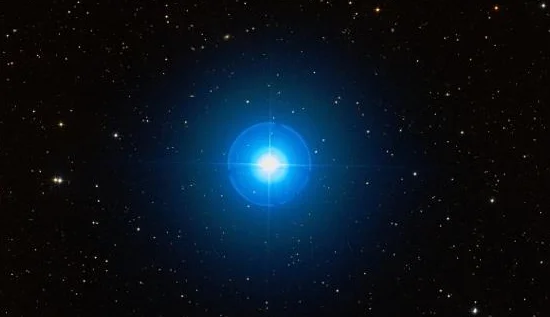
Cor Caroli (Alpha Canum Venaticorum), image: Wikisky
The brightness of Alpha2 CVn varies between magnitude 2.84 and 2.98 with a period of 5.47 days. The star serves as the prototype for its own class of variable stars, the Alpha2 Canum Venaticorum variables. Like Cor Caroli, these stars are chemically peculiar main sequence stars with strong magnetic fields and overabundances of some metals. Their brightness typically fluctuates by 0.01 to 0.1 magnitudes with a period of 0.5 to 160 days.
The variations in brightness are believed to be caused by an uneven distribution of metals in the stellar atmospheres so that different parts of the stellar surfaces are not evenly bright. The overabundant metals are concentrated into starspots that come in and out of view as the stars rotate, causing the brightness to vary from our point of view. The periods of the variations correspond to the stars’ rotation periods. Bright Alpha2 Canum Venaticorum variables include Alioth in the constellation Ursa Major, Mahasim in Auriga, Alpha Doradus in Dorado, and Mesarthim in Aries.
The companion, Alpha1 Canum Venaticorum or Alpha Canum Venaticorum B, is considerably fainter, shining at magnitude 5.60. It is a white main sequence star of the spectral type F2V. It lies a bit farther away, at a distance of 120 light years.
Alpha1 CVn has a mass of 1.47 solar masses and a radius of 1.48 solar radii. With a surface temperature of 7,080 K, it shines with 4.931 solar luminosities. It spins with a similar rotational velocity to Alpha2 CVn, 18 km/s.
Facts
Cor Caroli and its fainter neighbour Chara (Beta CVn) mark the southern of the two hounds represented by the constellation Canes Venatici. The Hunting Dogs, named Asterion and Chara, are typically depicted as being held by Boötes, the Herdsman, as he follows the Great Bear (Ursa Major) around the pole.
Cor Caroli marks the northern vertex of the Diamond of Virgo (the Great Diamond), a large asterism best seen in the evenings during the northern hemisphere spring. Located under the Big Dipper’s handle, the Great Diamond is also formed by Arcturus in the constellation Boötes, Spica in Virgo, and Denebola in Leo. Cor Caroli is the faintest of the four stars. The asterism can be used to find the Virgo Cluster of galaxies, the Coma Star Cluster, the Needle Galaxy (NGC 4565), the globular cluster Messier 3, and several other bright deep sky objects.
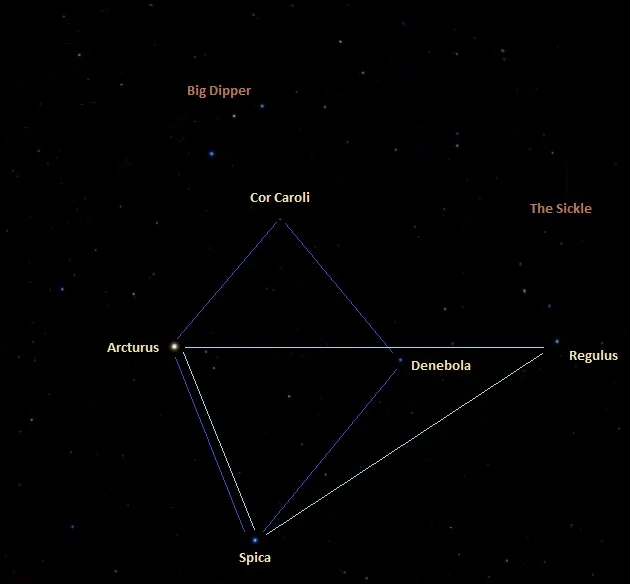
The Spring Triangle and the Great Diamond, image: Wikisky
Name
The name Cor Caroli (pronunciation: /ˌkɔːr ˈkærəlaɪ/) means “Charles’ heart” in Latin. The star was named by Sir Charles Scarborough, the physician to Charles II, who knighted him in 1669. It is uncertain whether Scarborough named the star in honour of Charles II, who restored the English monarchy in 1660, or his father Charles I, beheaded by Oliver Cromwell during the English Civil War in 1649. Scarborough claimed that the star appeared particularly bright on the night of Charles II’s return to England, which would suggest it was named after the son. However, the name first appeared on a star map by Francis Lamb in 1673 as Cor Caroli Regis Martyris (“the heart of the martyred King Charles”), which suggests that the name refers to the father.
The name was approved by the International Astronomical Union’s (IAU) Working Group on Star Names (WGSN) on July 20, 2016. It formally applies only to the component Alpha2 Canum Venaticorum.
The Chinese know Cor Caroli as 常陳一 (Cháng Chén yī), the First Star of Imperial Guards. The star forms the Imperial Guards asterism with Chara (Beta Canum Venaticorum), 10 Canum Venaticorum, 9 Canum Venaticorum, 6 Canum Venaticorum, 2 Canum Venaticorum, and 67 Ursae Majoris. The asterism is part of the Supreme Palace Enclosure, which represents the imperial court.
Location
Cor Caroli is very easy to find because it lies in the same area of the sky as the Big Dipper. The star is located about 17 degrees south of Alkaid, the star that marks the end of the Dipper’s handle. It is the brightest star directly below Alkaid.
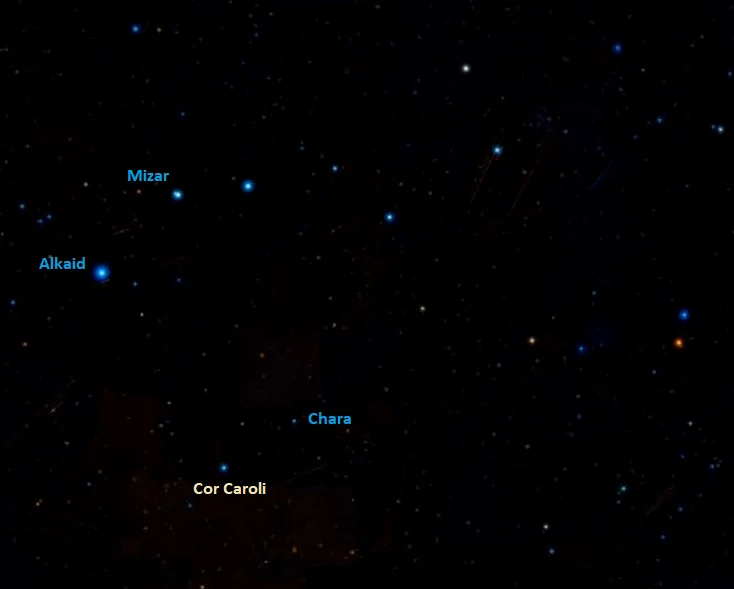
Cor Caroli location, image: Wikisky
Cor Caroli and its fainter neighbour Chara can be used to find the spiral galaxy Messier 94. M94 has an apparent magnitude of 8.99 and occupies an area of 11.2 by 9.1 arcminutes. It lies at an approximate distance of 16 million light years. It appears north of the imaginary line connecting Cor Caroli and Chara and forms a triangle with the two stars.
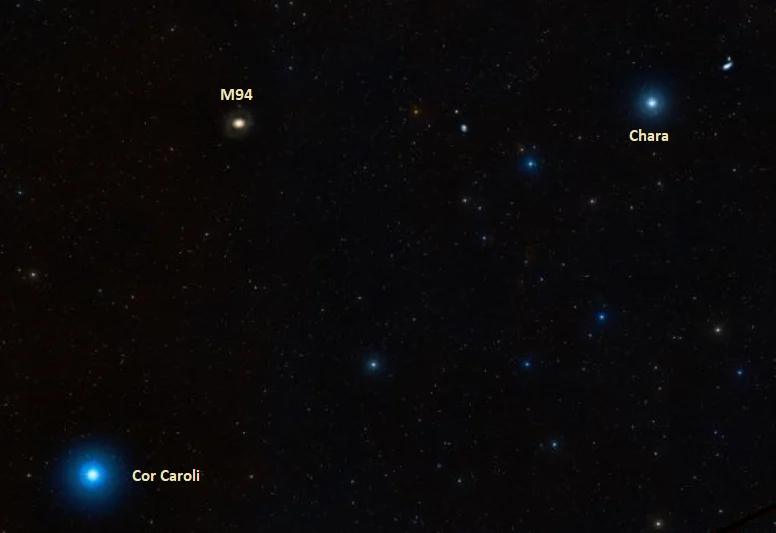
Chara, Cor Caroli and Messier 94, image: Wikisky
Several other relatively bright galaxies lie just east of Cor Caroli. NGC 4914 is an elliptical galaxy with an apparent magnitude of 11.5 and an angular size of 3.5 by 1.9 arcminutes. It lies approximately 210 million light years away. It forms a small galaxy group, catalogued as LGG 319, with NGC 4846 and NGC 4868. IC 4182 is slightly fainter, with an apparent magnitude of 11.86.
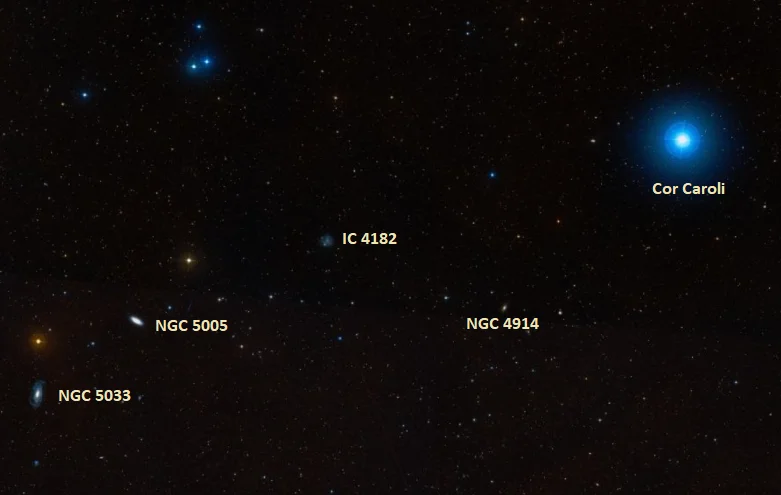
Cor Caroli, NGC 4914, IC 4182, NGC 5005 and NGC 5033, image: Wikisky
NGC 5005 is a spiral galaxy with a bright disk and high surface brightness. It has a visual magnitude of 10.6 and an apparent size of 5.8 by 2.8 arcminutes. It is interacting with NGC 5033, another spiral galaxy with a high surface brightness and a bright core. NGC 5033 has an apparent magnitude of 10.8 and an angular size of 10.7 by 5.0 arcseconds.
Constellation
Cor Caroli is located in the constellation Canes Venatici. Even though it represents the two hunting dogs held by Boötes, the Herdsman, Canes Venatici is not one of the Greek constellations. It was created by the Polish astronomer Johannes Hevelius in the 17th century. Hevelius created it from the faint stars located under the Great Bear’s tail.
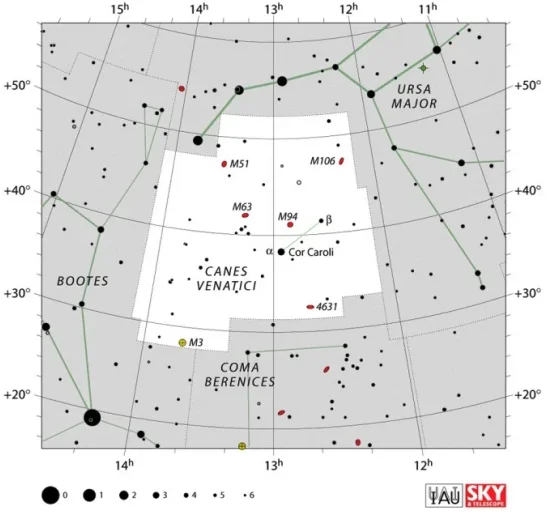
Canes Venatici constellation map by IAU and Sky&Telescope magazine
Occupying an area of 465 square degrees, Canes Venatici is the 38th largest constellation in the sky. It lies between the larger Boötes and Ursa Major and is bordered by the smaller Coma Berenices to the south.
Canes Venatici is known for its stars Cor Caroli, the solar analogue Chara (Beta Canum Venaticorum) and the carbon star La Superba (Y Venaticorum), one of the reddest stars in the sky. The constellation also contains the variable stars AM Canum Venaticorum, a prototype for a rare class of cataclysmic variable stars, and RS Canum Venaticorum, a prototype for a class of close binary stars with large stellar spots that cause variations in observed luminosity.
Canes Venatici is home to several well-known deep sky objects. These include the globular cluster Messier 3, located between Cor Caroli and Arcturus, and a few bright spiral galaxies, among them the famous Whirlpool Galaxy (Messier 51) and its dwarf companion NGC 5195, the Sunflower Galaxy (Messier 63), Messier 94, Messier 106, the Whale Galaxy (NGC 4631), and the interacting galaxies NGC 4656 and NGC 4657, also known as the Hockey Stick Galaxies or the Crowbar Galaxy.
The best time of year to see the stars and deep sky objects in Canes Venatici is during the month of May, when the constellation rises high above the horizon in the evening sky. The entire constellation is visible from locations between the latitudes 90° N and 40° S.
The 10 brightest stars in Canes Venatici are Cor Caroli (Alpha CVn, mag. 2.81), Chara (Beta CVn, mag. 4.26), 24 Canum Venaticorum (mag. 4.68), 20 Canum Venaticorum (mag. 4.715), AW Canum Venaticorum (mag. 4.73 – 4.85), 5 Canum Venaticorum (4.767), 25 Canum Venaticorum (mag. 4.82), BH Canum Venaticorum (mag. 4.91), HD 115004 (mag. 4.94), and 6 Canum Venaticorum (mag. 5.01).
Alpha Canum Venaticorum
| Constellation | Canes Venatici |
| Names and designations | Alpha Canum Venaticorum, α CVn, 12 Canum Venaticorum, BD+39° 2580, ADS 8706 AB, CCDM J12560+3819, IDS 12514+3851, WDS J12560+3819 |
Cor Caroli – Alpha2 Canum Venaticorum
| Spectral class | A0pSiEuHg |
| Variable type | Alpha2 Canum Venaticorum |
| U-B colour index | -0.32 |
| B-V colour index | -0.12 |
| Apparent magnitude | 2.84 – 2.98 |
| Absolute magnitude | 0.16 ± 0.08 |
| Distance | 115 ± 4 light years (35 ± 1 parsecs) |
| Parallax | 28.41 ± 0.90 mas |
| Radial velocity | -4.10 ± 0.2 km/s |
| Proper motion | RA: -235.08 ± 0.69 mas/yr |
| Dec.: 53.54 ± 0.55 mas/yr | |
| Mass | 2.97 ± 0.07 M☉ |
| Luminosity | 101 ± 12 L☉ |
| Radius | 2.49 ± 0.26 R☉ |
| Temperature | 11,600 ± 500 K |
| Age | 165 million years (95 – 225 million years) |
| Rotational velocity | 18.4 ± 0.5 km/s |
| Rotation | 5.46939 days |
| Surface gravity | 3.9 ± 0.1 cgs |
| Right ascension | 12h 56m 01.6662171s |
| Declination | +38° 19′ 06.154110″ |
| Names and designations | Cor Caroli, Alpha2 Canum Venaticorum, α2 CVn, Alpha Canum Venaticorum A, α CVn A, 12 Canum Venaticorum A, HD 112413, HR 4915, HIP 63125, FK5 485, SAO 63257, BD+39 2580, AG+38 1225, GC 17557, GCRV 7733, PPM 76815, LTT 13717, NLTT 32338, ASCC 494743, JP11 2336, IRAS 12536+3835, 2MASS J12560168+3819059, PLX 2969, UBV 11678, TYC 3021-2645-1, ADS 8706 A, CCDM J12560+3819A, IDS 12514+3851 A, WDS J12560+3819A |
Alpha1 Canum Venaticorum
| Spectral class | F2 V |
| U-B colour index | -0.03 |
| B-V colour index | +0.34 |
| Apparent magnitude | 5.60 |
| Distance | ~ 120 light years (40 parsecs) |
| Parallax | 30.3861 ± 0.0935 mas |
| Radial velocity | -0.76 ± 0.15 km/s |
| Proper motion | RA: -233.718 ± 0.176 mas/yr |
| Dec.: 61.549 ± 0.130 mas/yr | |
| Mass | 1.47 ± 0.15 M☉ |
| Luminosity | 4.931 L☉ |
| Radius | 1.48 R☉ |
| Temperature | 7,080 K |
| Rotational velocity | 18 km/s |
| Surface gravity | 4.25 ± 0.22 cgs |
| Right ascension | 12h 56m 00.4316668750s |
| Declination | +38° 18′ 53.468304880″ |
| Names and designations | Alpha1 Canum Venaticorum, α1 CVn, Alpha Canum Venaticorum B, α CVn B, 12 Canum Venaticorum B, HD 112412, HR 4914, HIP 63121, SAO 63256, BD+39 2580B, AG+38 1224, ASCC 494741, PPM 76814, GC 17556, GCRV 7732, LTT 13718, NLTT 32336, JP11 2335, 2MASS J12560044+3818533, UBV 11679, TYC 3021-2646-1, Gaia DR2 1517698613271363840, ADS 8706 B, CCDM J12560+3819B, IDS 12514+3851 B, WDS J12560+3819B |